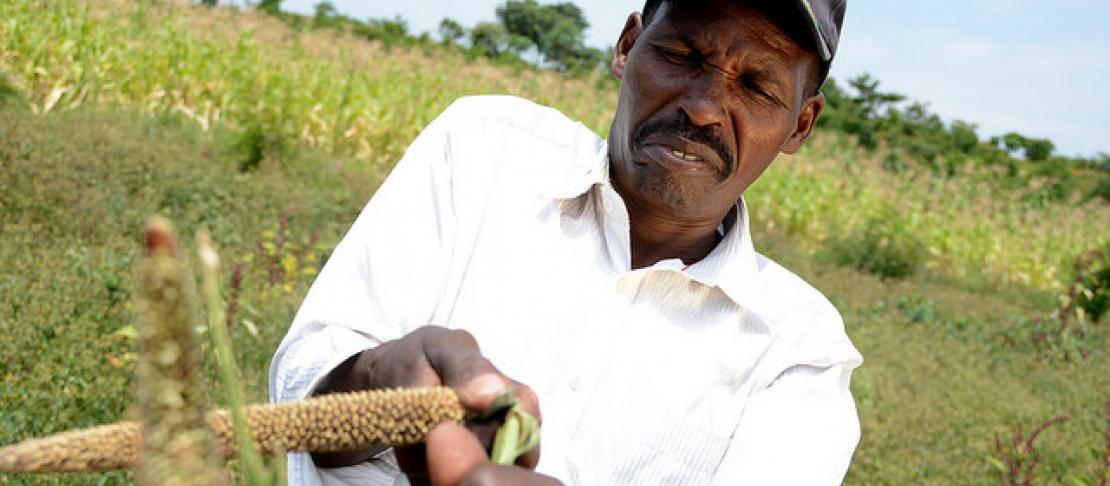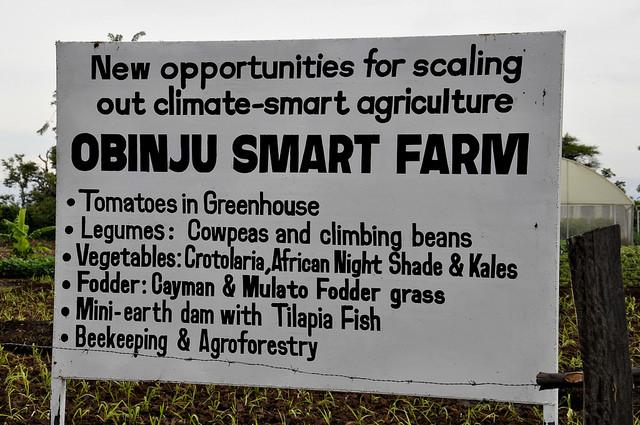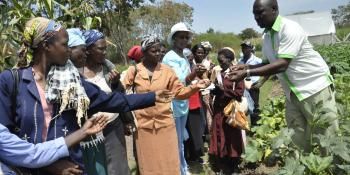Building environmental resilience: how farmers in Kenya adapt to climate change

New report features CCAFS work, documents how farmers are adapting to climate change.
In July 2015, Greenpeace Africa released a comprehensive report providing insights into ways in which Kenyan smallholder farmers are adapting to climate change and building climate resilience. The report presents case studies under four main themes: diversity, water, soils and communities. It further highlights strategies used by farmers to respond to climate related risks, including changing rainfall patterns, a new range of pests and diseases, and extreme weather events like drought and flooding.
The report profiles a number of champion farmers from different agro-ecological zones in Kenya. Two of these farmers are from the CGIAR Research Program on Climate Change, Agriculture and Food Security (CCAFS) Nyando climate-smart villages in western Kenya, who are undertaking participatory application of CGIAR resilient technologies. The studies were showcased through a public exhibition held between 31 July and 2 August at the National Museums of Kenya in Nairobi.
Focus area one: diversity across the agricultural system
Agricultural diversity ensures farmers have a range of options to draw from, making them food and income secure. This can be achieved with new crop types, improved seed varieties as well as through resilient livestock breeds.
Karen Onyango, a CCAFS champion farmer has embraced diversity on her five acre farm in Western Kenya. A wife, and mother to ten children, Karen has thirteen different crop and livestock enterprises. For example, she intercrops stress tolerant green grams and cowpeas (released by the International Crops Research Institute for the Semi-Arid Tropics - ICRISAT), together with maize (varieties released by the International Maize and Wheat Improvement Center - CIMMYT). Additionally, she grows a range of horticultural crops that have a ready market in the local community. She also keeps resilient Galla goats and Red Maasai sheep bred by scientists from the International Livestock Research Institute (ILRI). These livestock are used for crossing with local breeds in the community.
Focus area two: water management
In order to ensure the availability and efficient use of water, farmers have put in place conservation techniques. John Obuom, another CCAFS champion farmer in western Kenya, has created micro-catchment water reservoirs on his four acre farm. He has also established two water pans reinforced by dam liners (plastic sheets) where he captures surface run off. By using a manual foot pump, he is able to irrigate his crops and provide water for his animals for up to six months after the end of the dry season. John has planted a variety of trees for soil fertility improvement (Grevillea, Casuarina, Gliricidia), family nutrition and income (papaya and mango), as well as for fodder and fuelwood. This way, he is able to keep the soil healthy and also earn income from selling different products. John acquired tree seedlings as well as technical advice from scientists at the World Agroforestry Centre (ICRAF) working with farmers in the region.
Read more about Obuom and the Nyando CSV activities: Inspiring action: Nyando climate-smart villages host policy makers
Focus area three: soils
In this section, soil fertility improvement was explored, using locally available resources. The report profiles farmer Prisca Mayende, who has adopted practices that encourage healthy soils. A wife and mother to nine, Prisca practices alley cropping; planting nitrogen fixing trees such as Sesbania between rows of crops. Moreover, she uses leaves from some of these trees as feed for her dairy cow; a crossbreed adapted to local conditions. She practices mulching and composting to improve soil fertility and increase water retention for better crop establishment.
Focus area four: strengthening community support networks
This theme explores use of farmer participatory research as well as access to information, training and finance to encourage change. A key example provided is the Farmer Field Schools Initiative (FFSI) in Bondo, Western Kenya. This approach, supported by the UN Food and Agriculture Organization (FAO), entails the establishment of a small demonstration plot where the entire crop cycle is displayed, from sowing to cultivation. Farmers attend every week and work together to implement different practices with guidance from experts. The farmers are free to experiment and learn by doing.

Photo: V. Atakos
CCAFS East Africa has a similar approach at the Nyando CSVs where Community Based Organisations (CBOs) play a key role in enhancing the adaptive capacity of their members. These groups have an innovation fund that is sued to finance the establishment of communal demonstration farms with the guidance of agricultural extension officers and researchers. These farms are used as village experimental sites, showcasing new crop types and resilient varieties suitable to the local conditions. Furthermore, they facilitate multiplication and supply of seeds and planting material to other farmers in the villages.
What are the recommendations?
On the basis of the evidence arising from the case studies in the report, Greenpeace proposes to put climate change at the forefront of agricultural development and suggest that stakeholders should take into account early action on adaptation with mitigation co-benefits”, says Dr. James Kinyangi, Program Leader, CCAFS East Africa.
Key recommendations in this report include:
- Donors, governments and international organisations should increase overall financial, research, and technical support to ecological farming
- County and national governments should increase investment in policies that promote ecological farming, particularly for small scale farmers.
- Private companies and public institutions need to link up with small-scale farmer associations to supply ecologically grown produce
- Better monitoring and assessment of resilience-building initiatives
- Farmer participation: Projects should ensure participation of relevant communities especially small-scale farmers and women.
- More coordinated policy making. This will ensure synergy with the various development goals.
- Use of farmer field schools. For example, government can integrate these into its agricultural policy extension programmes.
Download the comprehensive report (PDF)
Thompson K, Kruszewska I, Tirado R. 2015. Building environmental resilience: A snapshot of farmers adapting to climate change in Kenya. Greenpeace Research Laboratories Technical Report: 04-2015.
Greenpeace is an independent global campaigning organisation which acts to change attitudes and behaviour, to protect and conserve the environment and to promote peace. Find out more on the Greenpeace website.
Vivian Atakos is a Communication Specialist at CCAFS East Africa.
John Recha is a Post Doctoral Fellow - Participatory Action Research at CCAFS East Africa.




